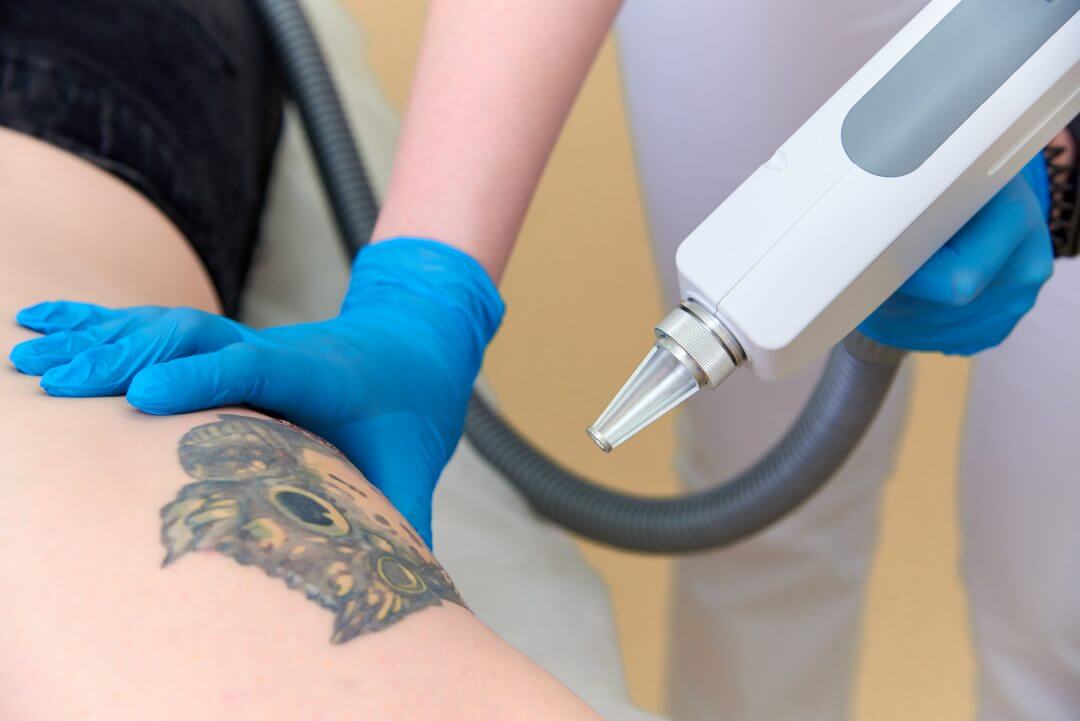Are you thinking about having a tattoo removed?
When done correctly, laser tattoo removal can make your skin look like it’s never been touched by ink. However, in order to get the best results possible, you need to make sure you take the appropriate aftercare steps.
What do you need to do?
Check out this guide to discover everything you need to know about tattoo removal aftercare.
Ice the Area
You should ice the tattoo removal area immediately following your appointment.
You should apply ice to the area in 1 to 3-minute increments, as this will help alleviate the heat and prevent blistering. However, make sure you’re not applying ice directly to the skin. The ice should be in a compress pack to avoid infection.
Moisturize
It’s also very important that you moisturize the treated area. Moisturizer helps to promote healing and reduce itching and irritation.
In the first three days after treatment, you should apply moisturizer three to four times per day.
Rest and Elevate
On the day of your treatment, you should limit your physical activity as much as possible. While it’s okay to do a bit of walking around, engaging in strenuous exercise can slow the healing process, as exercise can reduce blood flow to the treated area.
If you’re having a tattoo removed on your foot, ankle, or lower leg, you should also avoid getting a pedicure until your skin has fully healed. This is because the tattoo removal laser causes tiny abrasions in the skin. Soaking your feet in a pedicure tub could cause these abrasions to become infected.
In addition to resting, you should also keep the treated area elevated above the heart, as this will help decrease the chance of blistering. Again, this is especially important for tattoos that are on the foot, lower leg, and ankle.
Shower
You can shower three hours after your tattoo removal session. However, you should avoid using high water pressure in the shower, as this can irritate the treated skin.
Before you hop in the shower, make sure to remove your bandages. You can then clean the area gently with mild soap and then pat it dry. Be careful to not soak the area until it has fully healed, as this can lead to infection and scarring.
This means that you should avoid hot tubs, bathtubs, and swimming pools.
Watch Out for Skin Reactions
During the healing process, it’s very important that you keep your eye out for skin reactions. It’s important to understand that itching and blistering are normal.
If you do get blisters, don’t break them, as this can lead to scarring. Instead, wait for them to heal naturally. If you find that your blisters are uncomfortable, you can call the tattoo removal clinic to have them drained. Typically, blisters resolve themselves in one to two weeks.
It’s also a good idea to use a non-stick bandage to protect the blister. If a blister does break, apply some healing ointment to the area. In most cases, blisters form within the first eight hours of a tattoo removal treatment. However, it’s important to keep in mind that not everyone blisters from tattoo removal.
Itching is another very common skin reaction that you shouldn’t worry about. You can apply hydrocortisone cream to help you resist the temptation to itch.
While itching and blistering are normal skin reactions, bruising, tingling, and swelling are not. If you experience any of these skin reactions, you should get ahold of your tattoo removal clinic.
Keep Your Immune System Strong
In order to properly recover from a tattoo removal session, it’s very important that you keep your immune system strong. The stronger your immune system is, the faster your skin will heal.
Here are some things you can do to strengthen your immune system:
- Drink plenty of water- This will help flush out toxins and restore blood cells
- Avoid smoking
- Decrease your alcohol consumption (too much alcohol can lead to dehydration)
- Exercise to increase blood flow (you should wait a few days before resuming your exercise regime)
Also, make sure you’re eating a well-balanced diet and getting plenty of sleep.
Stay Out of the Sun
If someone experiences improper healing after a tattoo removal session, it’s more often than not due to sun exposure. Staying out of the sun is perhaps the most important thing you can do when healing.
Exposing your skin to the sun can lead to blisters, broken skin, and scarring. Plus, getting a sunburn will mean you need to delay the time until your next tattoo removal session, as your skin needs to be at its normal color when having a tattoo removed.
Try to stay out of the sun as much as possible following your tattoo removal. While you should be wearing sunblock at all times when going outside, it’s especially important to cover the treated area with sunscreen in the three months following your tattoo removal session.
This is the case even if the treated area is covered by clothing. Also, remember to reapply your sunscreen every couple of hours.
Tattoo Removal Aftercare: Now You Know
Now that you’ve read this tattoo removal aftercare guide, it’s time to put these tips into action. Following this guide will ensure that your skin heals as best as possible.
When your skin is healing, you can also start thinking about your next tattoo removal appointment. Typically, it takes anywhere from 3 to 10 sessions to fully remove a tattoo. You should wait at least 6 weeks before your next appointment, but you can schedule it anytime you like.
You can contact us today if you’re looking to schedule a tattoo removal appointment in the Massachusetts area.


